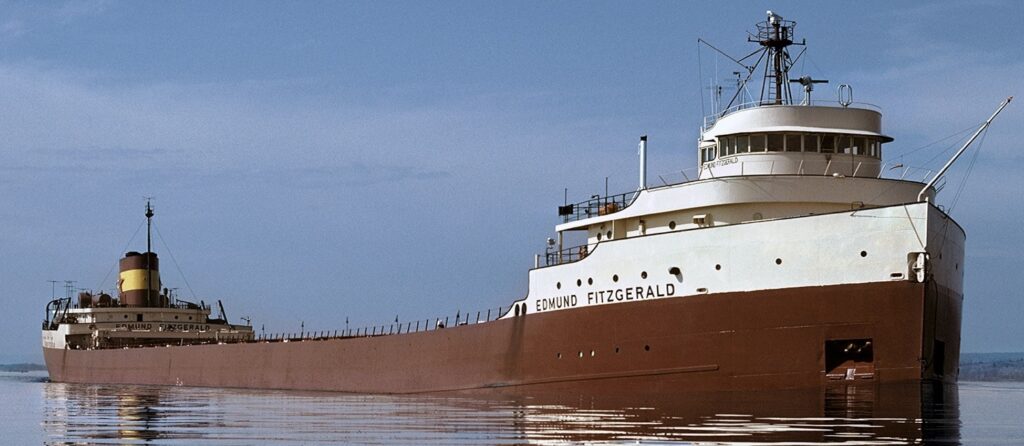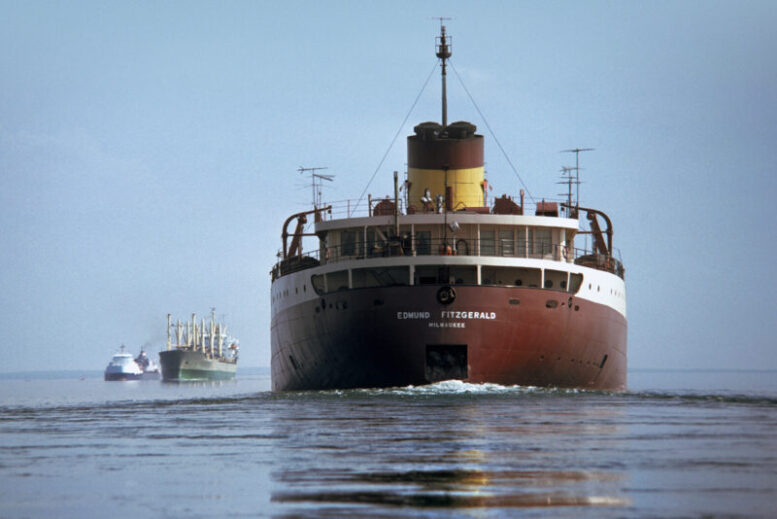By JAN LARSON McLAUGHLIN
BG Independent News
The Edmund Fitzgerald was just 5 years old when a young Tom Walton was hired for his first real job as a porter on the largest ship on the Great Lakes.
A dozen years later, the ship plunged to the bottom of Lake Superior, taking its 29 crew members with her. Walton’s uncle, an oiler in the engine room, was among the souls lost.
To this day, 48 years later, it remains a mystery how the ship was lost just 17 miles from the shelter of Whitefish Bay, Michigan. Memorialized by Gordon Lightfoot’s haunting ballad, “The Wreck of the Edmund Fitzgerald,” the tragedy is still fresh for many in this region, home to many of the crew members.
Walton, retired editor of the Toledo Blade, shared his memories of working on the ship and some theories of how the fatal storm claimed the Fitzgerald and her crew. He spoke Thursday to the Bowling Green Kiwanis Club.
“The Fitzgerald was the pride of its fleet – considered invincible,” Walton said. “Toledo was her primary port of call,” with the freighter often spending winter at local docks.
She was launched in 1958 at River Rouge, Michigan. At 729 feet and 13,632 tons, she was the biggest ship on the Great Lakes for more than a decade. The Fitzgerald was the largest man-made object ever dropped into fresh water, Walton said.
When she went through the Soo Locks, connecting Lake Superior with the smaller Great Lakes, the Fitzgerald had one foot to spare for length, and a whisker to spare for width.
“There was no margin for error,” Walton said.
The Fitzgerald’s job was moving iron ore from Minnesota to steel mills in the Toledo and Detroit area. She was heralded as the flagship of her fleet and respected by those who traversed the lakes.
“She was a legend on the lake,” Walton said, noting that the ship set tonnage records every shipping season. “She was held in awe.”

As a young crew member, Walton was charged with feeding the crew and taking care of passengers on the freighter. For a period, his father served as chief on the ship.
Walton had moved on from crewing ships and his dad was no longer chief of the Fitz when tragedy took down the freighter on Nov. 10, 1975. But his uncle was still on board – likely in the engine room at the time.
As was customary, the empty freighter had sailed from Toledo to Wisconsin for its cargo. There it was loaded down with 26,116 tons of iron ore pellets.
“We ran very low when we had a belly full of iron ore,” Walton said. “She was no match for nature’s fury, especially when fully loaded.”
The original version of Lightfoot’s song about the Fitzgerald mentioned the ship hatches taking on water. He later changed that line so as not to imply crew error.
“The crew on the Fitz was the best of the best,” Walton said.
“I think the Fitzgerald was simply carrying too much in the cargo hold,” Walton surmised.
The tons of iron pellets were like marbles pitching backward and forward in the storm, he said. The ship was taking on water, and the waves were relentless.
“She could not recover,” and the engines likely plowed the ship into the lake bottom, Walton said. “The next moment, she simply disappeared. There was not even time to call for help.”
Several theories have been suggested over the nearly half century since the ship and crew were lost in the freezing waters of Lake Superior.

The ship’s radio communications with another nearby freighter, the Anderson, have been scoured for details. The Anderson was about 10 miles behind the Fitz on its way to Whitefish Point.
The Great Lakes Shipwreck Historical Society’s three expeditions to the wrecksite revealed it was likely the ship “submarined” bow first into an enormous wave. But what caused the ship to take on enough water to lose buoyancy and dive to the bottom so quickly, remains a mystery.
Records show that Captain Ernest McSorley of the Fitzgerald and Captain Bernie Cooper of the nearby Arthur M. Anderson freighter agreed to take the northerly course across Lake Superior because of the building storm from the Great Plains. The Fitzgerald, the faster ship, was in the lead, with both ships staying in radio contact.
Weather conditions continued to deteriorate. Gale warnings issued on the evening of Nov. 9 were upgraded to storm warnings on the morning of Nov. 10. While conditions were bad, with winds gusting to 50 knots and seas 12 to 16 feet, both captains had often piloted their vessels in similar conditions, according to the GLSHS.
At 3:30 p.m. on Nov. 10, McSorley reportedly radioed Cooper and said the Fitzgerald was listing, a fence rail was down, and two vents had been lost or damaged. McSorley asked Cooper if the Anderson would stay by the Fitzgerald till it got to Whitefish. McSorley slowed his speed to allow the Anderson to close the distance.
As the afternoon wore on, radio communications between the ships continued, but McSorley shared no more alarming reports.
On the trailing Anderson, about 5:20 p.m., the crest of a wave smashed the Anderson’s starboard lifeboat, making it unusable. Cooper reported winds at a steady 58 knots with gusts to 70 knots, and seas of 18 to 25 feet, according to the GLSHS.
Around 6:55 p.m., Cooper and the men in the Anderson’s pilothouse felt a “bump,” noticed the ship lurch, and then turned to see a huge wave engulfing their entire vessel from astern. The wave worked its way along the deck, crashing on the back of the pilothouse, driving the bow of the Anderson down into the sea.
“Then the Anderson just raised up and shook herself off of all that water – barrooff – just like a big dog. Another wave just like the first one or bigger hit us again,” Cooper is reported saying according to the GLSHS. “I watched those two waves head down the lake towards the Fitzgerald, and I think those were the two that sent her under.”
The first mate of the Anderson, kept losing sight of the Fitzgerald on the radar because the seas were so high they interfered with the radar. The first mate spoke to the Fitzgerald one last time, about 7:10 p.m.
“We are holding our own,” McSorley reportedly said.
The radar signal, or “pip” of the Fitzgerald kept getting obscured. Around 7:15 p.m., the pip was lost again, but this time, it did not reappear. The Anderson’s first mate called the Fitzgerald again at about 7:22 p.m. There was no answer.
The Anderson reached Whitefish Bay around 8 p.m. At the request of the Coast Guard, the ship went back out into the storm to search for any evidence of the Fitzgerald, according to the GLSHS.
The Anderson turned out to be the primary vessel in the search, discovering the Fitzgerald’s two lifeboats and other debris but no sign of survivors. Only one other vessel, the William Clay Ford, was reportedly able to leave the safety of Whitefish Bay to join in the search at the time.
Years later, the 200-pound bell from the Fitzgerald was recovered from the wreckage and is now on display in the Great Lakes Shipwreck Museum in Whitefish. Another bell replaced it at the underwater site now declared a gravesite.
Video footage shows the split ship in its resting place.
“It’s a strange feeling to see passageways I walked through and ladders I climbed” in the watery grave, Walton said.
Walton said his dad lost his drive to sail on the Great Lakes. “He lost many good friends that night.”
Thirteen of the 29 crew members were from Ohio, with six being from Wood and Lucas counties. Walton’s uncle was from Fremont.
“Rest in peace, Uncle Grant,” Walton said. “May we never forget.”





